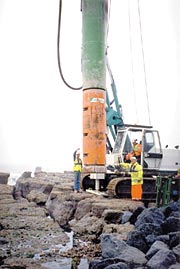
The Scarborough Borough Council recently approved the completion of a $40 million sea wall rebuilding campaign in order to protect its important coastline. The project will safeguard a 11⁄4-mile stretch of coastline along the The Holms, Castle Headlands and East Pier region, and is scheduled to take up to two years to complete. The contract for this task was awarded to Edmund Nuttall Limited and consultant High Point Rendell who have assigned all drilling for the project to Ritchies Equipment Ltd.
The project calls for installation of up to 308,560 tons of granite rocks from Norway, weighing up to 22 tons each, to build rock armor protection around The Holms, Castle Headland and East Pier. Pre-cast interlocking concrete blocks called Acropodes will also be used on Castle Headland and East Pier. These installations will require the drilling of 605 34-inch piles into the seabed to a depth of 9 feet to 15 feet in medium sandstone and mudstone. Of these 605 holes, 240 will be drilled on the beach at low tide with the remaining 355 completed at sea.
Numa's distributor, H&F Drilling, and Numa regional manager, Chris Beare, have been instrumental with the support of this drilling project by providing great insight into the products and methods being used. Both have played a critical role in designing complete drill strings for the land- and water-based drilling operations. Similar in both set-ups is the use of Numa Champion 240 hammers and 34-inch bits in order to provide the necessary combination of speed and performance.
The Champion 240 hammer is shrouded with a split sleeve to facilitate hammer disassembly with a large Scorpion unit available on site. The remaining drill string consists of a 10-foot joint of 12-inch pipe sleeved to achieve correct hole-cleaning characteristics. The total weight on bit is approximately 8 tons.
All beach drilling is carried out at low tide with a Casagrande B125 drilling rig, which tracks along a temporary beach road. Two 1,500-cfm/150-psi compressors are used to generate up to 3,000 cfm of air with the hammer typically running at 125 psi. All lubrication is provided by an ASL venturi type system supplying a marine and environmentally sensitive lubricant. To conduct drilling, the rig is accurately positioned over the pile location where care is taken to collar the hole and then drill to required depth. When the drilling is finished, the rig is moved off the hole and a precast 301⁄2-inch pile is located and grouted into position.
A Casagrande RM21 rig is conducting all drilling out at sea and contains the same compressor, lubrication and the basic drill string set-up that is used on the beach, but with a longer upper string due platform height from sea level. The RM21 is mounted on a base that slides along the platform “bull bar” to each hole position.
Each hole requires a 36-inch temporary casing to be socketed into the seabed; when the casing is positioned, a crane drops the hammer assembly and drill string into the hole. The rig is slid over the hole and connected to the drill string. Care is taken to collar the hole before drilling the socket 9 feet to 15 feet into the sea floor. Upon completion, the drill string is removed for use on the next hole. A precast concrete and steel pile then is dropped into the drilled hole and grouted through built-in tremie lines. The temporary casing is removed and reused on the next hole.
The larvic granite is transported from Norway by large ocean-going barges that anchor approximately 2,625 feet offshore, and the rock is lightered to smaller barges for delivery to the project location. For the sea defenses around North Bay, the rock was dropped on the sea bed/beach at high tide as close to the site as possible. At low tide, heavy earth-moving equipment adapted for handling large boulders maneuvered them into position against the existing sea wall. In the final stages, the Acropodes are set in position.
Any project calling for the installation of 605 piles in two different environments requires proper planning and selection of the right drilling solutions to yield consistent, reliable results. In the early stages of this project, it is clear that the foresight of Ritchies to utilize both the experience and products offered by H&F Drilling and Numa has paid off. Ritchies has realized an average penetration rate of 16 feet per hour and has been able to meet its projected plan for pile installation. With these results, the Scarborough coastline along The Holms, Castle Headland and East Pier will be protected for generations to come.
ND
Report Abusive Comment